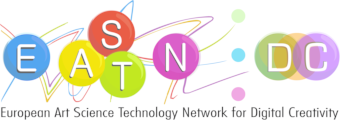Summary: Following Bachimont's theoretical analysis on the affinities between Engineering and Artistic work, Design Engineering students are confronted to artistic challenges and urged to implement detailed design prototypes. In this paper we describe the process, outcomes and lessons learned from an intensive workshop applying digital storytelling techniques to an interaction design course.
Abstract: Introducing his theoretical framework on the sense of the technique, Bachimont distinguished affinities between Engineering and Artistic work based on the concrete coherence of doing things in a technical process, by mastering materials with the final goal of a possible outcome. In this Engineering practice two paradigms are opposed: the technician, able to control the correct application of the specifications, and the artist, able to question the limits of the specifications and propose original outcomes.
Following Bachimont's analysis, we experiment, since 2013, the possibility to trigger Engineering practice via the introduction of artistic freedom in the creation of interactive applications, what we can call the "Leonardo da Vinci effect". These experiments take the form of an intensive workshop with students, undergraduate and post-graduate, but also professionals attending Summer Schools. The participants to the workshop come with a rough idea of specifications for the implementation of a work and they must implement a collective interactive outcome in groups of 3-5 persons, using interaction design methods and digital storytelling techniques. In this paper we describe the process, outcomes and lessons learned from an intensive workshop organized at the Department of Product and Systems Design Engineering of the University of the Aegean at Syros island. The students were asked to apply Character Design techniques to implement high-end interactive prototypes able to interact with human audience.
•Bachimont, Bruno (2010). Le sens de la technique: le numerique et le calcul, Edirions Les Belles Lettres.
•Banfield, R., Lombardo, C. T., & Wax, T. (2015). Design sprint: A practical guidebook for building great digital products. " O'Reilly Media, Inc.".
•Ferreira, V. G., & Canedo, E. D. (2020). Design sprint in classroom: exploring new active learning tools for project-based learning approach. Journal of Ambient Intelligence and Humanized Computing, 11(3), 1191-1212.
•Ferreira, V. G., & Canedo, E. D. (2019, April). Using design sprint as a facilitator in active learning for students in the requirements engineering course: an experience report. In Proceedings of the 34th ACM/SIGAPP Symposium on Applied Computing (pp. 1852-1859).
•Forest, C. R., Moore, R. A., Jariwala, A. S., Fasse, B. B., Linsey, J., Newstetter, W., ... & Quintero, C. (2014). The Invention Studio: A University Maker Space and Culture. Advances in Engineering Education, 4(2), n2.
•Larusdottir, M., Roto, V., Stage, J., Lucero, A., & Šmorgun, I. (2019, September). Balance talking and doing! Using Google Design Sprint to enhance an intensive UCD course. In IFIP Conference on Human-Computer Interaction (pp. 95-113). Springer, Cham.
•Sari, E., & Tedjasaputra, A. (2017, September). Designing valuable products with design sprint. In IFIP Conference on Human-Computer Interaction (pp. 391-394). Springer, Cham.
•Toda, A. M., Palomino, P. T., Oliveira, W., Rodrigues, L., Klock, A. C., Gasparini, I., ... & Isotani, S. (2019). How to gamify learning systems? an experience report using the design sprint method and a taxonomy for gamification elements in education. Journal of Educational Technology & Society, 22(3), 47-60.
Back
“Reflections: Bridges between Technology and Culture, Physical and Virtual”
is supported by:






